Tunze (technically Tunze Aquarientechnik GmbH, and pronounced ‘tune-zah’) is a name familiar to most serious reef aquarium hobbyists. Headquartered in Penzburg, Germany, Tunze has been manufacturing products for the aquarium market since 1960. Their products are noted for quality and upper-end pricing. This month, we’ll examine some of the finer points of a tunze product – the Wavebox 6215, and more specifically its pump (Turbelle Model 6260) and controller (Model 6091).
For a variety of reasons, not every report on products I purchase and test makes it to print. In some cases, the product performs so poorly that the manufacturer’s business fails before the possibility of publication. Other times, the testing protocol does not generate results worthy of publication, and this was my initial experience with the tunze
Wavebox. It is not that the product did not achieve results I would have expected based on tunze’s reputation – it was that the application was incorrect, although it would take a while to realize this fact. In initial experiments, the Wavebox produced a lot of flow but failed to produce significant wave action (a subjective opinion) when used in a 100-gallon Rubber Maid™ tub. Since I had to build a frame of PVC pipe to hold the box in place, this positioning allowed the waves to pass behind the Wavebox, where they then formed an odd rebound (reflection) once striking the curved wall of the tub. Even after weeks of trying to tweak the controller and timing of the waves, I failed to do so and considered the test a failure and abandoned use of the Wavebox. Almost two years later, I decided to try again. The box was too large to fit inside the rectangular aquarium so I used only the pump and controller – with profoundly different results from those originally seen.
tunze makes many claims about the Wavebox – a pump producing ‘high speed’ currents while using little power, wave heights of 3 cm (1.18 inches) with oscillations corresponding ‘precisely’ to wave action seen on natural reefs. How do these claims hold up under scrutiny?
Tested Products and Specifications
- Controller: 6091 Wave Controller
- Pump: Turbelle Stream 6260.10
- Power Consumption: The tunze pump and controller operate on Direct Current at reduced voltage and is rated by Tunze at 62 watts (1.49 kWh per day). Power consumption differs at various wattages – 18 watts on average @18v, 26 watts @ 24v per tunze’s website)
- Intake diameter = 92mm (3.62 inches)
- Intake Circumference: 289mm (11.4 inches)
- Discharge diameter = 55mm (2.17 inches)
- Volute length = 60mm (2.36 inches)
- Propeller Diameter = 49mm (1.93 inches)
- Motor Diameter = 92 mm (3.62 inches)
- Total Cord Length: 6.35 meters (20.8 feet)
- Cord Length (from outlet to transformer): ~165 cm (~5.5 feet)
- Cord Length (from transformer to controller): 6.35 meters (20.8 feet)
- Cord Length (from controller to pump): 2.87 meters (9.4 feet)
The Wavebox
The Wavebox is simply a rectangular container that houses the pump and collects water to be pumped. It is rather large and intrusive in all but the largest aquarium.
tunze recommends it for aquaria sized from150 to 1,500 liters (39 to 396 US gallons).
The Wavebox’s dimensions are:
- Length: 125mm x Width: 113mm x Depth: 300mm (4.9″ x 4.4″ x 11.8″)
- Immersion depth = 280mm (~11″)
The size of this box would make it too large for use in testing, and this concludes our discussion of the Wavebox itself.
Wave Controller 6091
The controller does exactly that – it controls the timing of the pump’s on/off cycles. Sophisticated electronics allow fast cycling (approximately 1 second on and one second off) and slow cycling (2 seconds on/2 seconds off) with a practically infinite number of adjustments in between. Adjustments are done with a rotary knob (a potentiometer).
The 6091 controller incorporates a ‘Food Timer’ that shuts the pumps down for feeding fishes. The down time is about 7 to 9 minutes.
A Master/Slave function allows use of two Waveboxes on one controller.
Flow Rates
Water motion is every bit (if not more so) important than lighting. Water motion can actually regulate photosynthesis to a degree in aquatic plants and organisms, but that is another story for a different time.
I measured water velocities at the pump’s discharge and calculated these flow rates:
- Up to 1,555 gallons per hour (gph) at fast cycling (1 second on/1 second off)
- Up to 1,459 gallons per hour (gph) at slow cycling (2 seconds on/ 2 seconds off).
- The maximum observed water velocity at the discharge was ~2.25 feet per second (~69 cm/sec). See Figure 2, and Testing Protocols (below) for details.
As we shall see, the flow rates tell only part of the story.
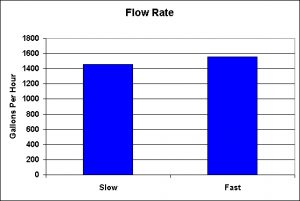
Figure 2. Maximum observed water velocities were used to calculate flow rates, and there was much difference at fast and slow pump cycling.
Theory of Operation
Intermittent operation of the pump through the controller harmonizes aquarium water movement with the pulse of water produced by the pump. Resonance creates a single large wave in small aquaria; a double wave is possible in aquaria exceeding about 2 meters (78 inches) in length. When a single wave is produced, its ‘pivot point’ is the center of the aquarium, and the wave is most pronounced at either end of the aquarium. See Figure 3.

Figure 3. A wave generated by the tunze pump and controller. The wave is almost at maximum height (about 1.5″) on the left hand side of the aquarium. Approximately 1 second later, this wave will crest on the right hand side. Note the two small waves to the center left – something I noticed only in photographs.
Power Consumption
Reef aquaria can be expensive to set up and maintain while electrical costs are of primary concern in the month-to-month operational costs. Power consumption was monitored over a period of time when the pump operating in both ‘fast’ and ‘slow’ cycling modes.
Fast Cycling (Approximately 1 second on/1 second off)
The pump used 610 watts in 19.5 hours, which is equal to 31.3 watts per hour (times 24 = 0.751 kW per day). The procedure was repeated with similar results: 760 watts were consumed in 24.48 hours for an average of 31 watts per hour.
Slow Cycling (Approximately 2 seconds on/2 seconds off)
The pump consumed 1,230 watts in 39.85 hours, for an average of 30.87 watts per hour. See Figure 4.
Since the pump operates on direct current, it and the controller can be operated by a battery. It can also be operated by a photovoltaic device (acquired through a solar panel dealer).
Heat Transfer
Direct Current (DC) motors offer some advantages (such as speed control) but this comes at a price – DC motors are notorious for operating at relatively high temperatures. Obviously heat is an enemy of a reef aquarium. Figure 5 shows the rise of water temperature during an eight hour period.
As the chart shows, the water temperature rose about 2ºF (3.6ºC) during the test period. The drop in temperature at 16:48 suggests the small aquarium (20 gallons) was under the influence of the room’s air temperature (even though it is air conditioned). There is little doubt that the tunze pump warmed the water somewhat, however the aquarium is smaller than the minimum size recommended by tunze. In short, heat transfer from the pump to the ambient is minimal.
Routine Maintenance
As with any pump, the Turbelle pump will require routine maintenance.
Generally this includes removal of calcium deposits and bio-growths. Disassembly is easy, and the parts are robust and do not seem subject to breakage. tunze recommends soaking the parts in vinegar to dissolve deposits.
Maximum Operating Temperature
I found it amusing (in a morbid sort of way) that tunze recommends a maximum operating temperature for the pump of 35ºC (95ºF) with failure of the magnets occurring at 50ºC (122ºF).
Since this product is geared towards reef aquaria, any temperature exceeding roughly 27ºC (80ºF) should be avoided!
Other Features
The pump is thermally protected, meaning it will shut down in case it becomes too hot.
Also, it will shut down if pump propeller is blocked. A photo-sensor is available – this will shut down the pump when the lights go off. Personally, I believe this option should be avoided as corals need good water circulation at all time.
Price
The Manufacturer’s Suggested Retail Price is $543.98, plus tax and shipping, and that seems to be the price we’ll pay. I was unable to find a better price when I did some internet searches.
Warranty
tunze guarantees the Wavebox, pump, controller and related equipment to be free from defects in materials and workmanship.
Conclusions
Judging the Turbelle pump strictly on its flow rate and power consumption would lead an aquarist to conclude its performance is less than impressive. After all, smaller much less expensive propeller pumps can produce higher flow rates while using less power.
The game changer is the controller. In my case, the rapid cycling produced waves of about 1.5 inches (38mm) in height. The oscillating wave action does indeed produce homogenous water movement. This motion sweeps the aquarium of settled detritus and sets in motion some interesting side effects.
After the Turbelle pump had been fine tuned, I noticed the protein skimmer (an ETSS model 800) was collecting an unusual amount of material. The foam in the skimmer’s chimney – usually white – had assumed a tan coloration, and the skimmate was darker. After two days’ operation, the bottom of the aquarium was almost completely scoured of detritus and the skimmer was collecting very little material. The skimmate had turned from a viscous brown to a weakly colored, almost clear, liquid. The aquarium itself, for want of a better word, sparkled and the water appeared a crisp blue-white. tunze’s advertising claim of a ‘sweeping action’ is correct.
It should come as no surprise that the power consumption remains unchanged when operating the pump in ‘fast’ or ‘slow’ mode. After all, the ratio of time on and off remains essentially the same. Though the pump’s power usage is on the high side (when compared to smaller pumps producing the same or higher flow rate), the resonance effect makes 30-31 watts seem a bargain. Of all tunze’s claims, I was most skeptical of this pump/controller replicating ‘precisely’ the water motion in nature. I didn’t expect to see the wind-induced rolling action of waves called Langmuir’s cells, but I surely didn’t think the velocity would approach that I’ve measured on sheltered reefs here in Hawaii. And I would be wrong. My water velocity meter (see Testing Protocols below) reported a water speed of up to 0.41 feet per second (4.92 inches per second, or ~12.5 cm/sec). Compare this to an average water velocity of ~6″/sec (15.2 cm/sec) I’ve measured on reefs here in Hawaii.
Incredibly, tunze’s claim is close enough (!). See Figure 6. Note: Water velocity can be much higher on a natural reef, especially during storm-induced surge, or ‘rip-tides’, where getting in the water to measure water velocity is much too dangerous.
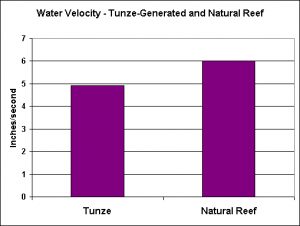
Figure 6. Water velocities in an aquarium employing a tunze pump, and that measured on a calm day on a natural reef.
Pumps using DC current have the advantage in that their speed can be easily controlled. Since the pump is designed to spin the propeller in one direction only, the ‘chatter’ created by propellers making contact with a stop in propeller pumps using AC current is avoided. This tunze pump operates silently with no whining noise noted in some other DC pumps. Its operation is so quiet that I have to look at aquarium’s wave action to see if the pump is operating.
Since this pump operates at low voltage (18-24 volts) making it very safe for use in highly conductive seawater. The pump voltage is set at 18 volts at the factory, but can be changed by the end user by installing an electrical jumper wire.
Heat transfer from the pump to the water is a non-issue. When the pump was housed in a smaller than recommended aquarium, only a slight rise in water temperature was noted and even this small increment was probably influenced by room temperature. tunze’s claim of low heat transfer is justified.
I should note that I do rely on only the tunze pump to create water movement. A smaller propeller pump made by Sea Flo is also used to mop up some of those dead spots (see www.advancedaquarist.com/2007/12/review1 for details).
The major drawback is price. A pump and controller costing over $550 is hard to justify in today’s economy. However, my only regret is that I did not purchase one of these earlier.
Testing Protocols
The first problem encountered in the second round of testing, where only the pump and controller were used, was how to mount the pump to the aquarium wall. I used the powerhead mounting hardware manufactured by SureGrip Attaching the rail mounting to the tunze pump with Super Glue was a no-brainer, and the internal magnet was held firmly with a Super Grip magnet on the outside of the tank. This seemed a quick and workable solution. Some bending of the rather fragile support rod was noted on startup. In less than 24 hours, the rod was badly fatigued by ~70,000 on/off cycles and finally snapped. Since the rod broke cleanly at the ball and socket, it was an easy matter to simply drill into the socket to allow for a sturdier support (the rod was deeply solvent-welded into the ball with ABS cement). A short length of polyethylene tubing was cemented in place to act as a pulse dampener between the pump and the magnetic mounting). Note: The Algae Free’s Sure Grip magnet system
(see: www.advancedaquarist.com/2007/12/review2/ for details) is designed to be used with much smaller pumps (such as Maxi-Jets) so it is unfair to expect it to support and much larger, heavier pumps. I have used the Sure Grip magnets and mounting hardware with smaller pumps for years with absolutely problems.
Once this problem was overcome, electrical power consumption was measured by a Kill-A-Watt meter marketed by P3, International.
Water velocity was judged by a magnetic flow meter (based on Faraday’s Principle) made by Marsh-McBirney, Maryland. This meter, the Flo-Mate 2000, is presently marketed by the Hach Company (Loveland, Colorado).
To determine flow rates, the information gathered by the magnetic flow meter was plugged into this simple formula:
- Flow = Velocity X Area
Where velocity is reported in inches per second and area of the pump discharge is reported as square inches.
Water temperature was monitored with a NIST-traceable digital thermometer.
Questions? Comments? Please leave them in them ‘Comment’ section below.



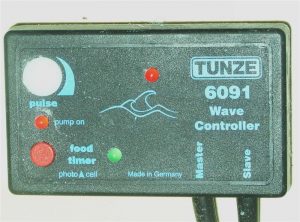
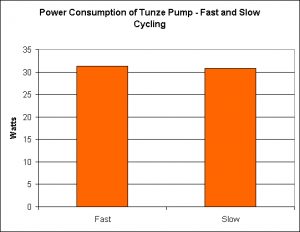
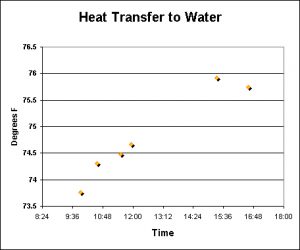

0 Comments